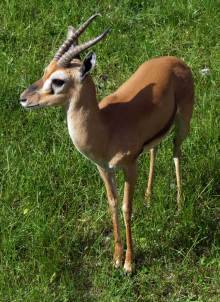Gazella arabica,
IUCN
LCBasic Information
Scientific classification
- name:Gazella arabica,
- Scientific Name:
- Outline:Ungulata
- Family:Artiodactyla Bovidae Gazelle
Vital signs
- length:No verification information
- Weight:No verification information
- lifetime:No verification information
Feature
Distribution and Habitat
The Arabian gazelle is found in Oman, Saudi Arabia, the United Arab Emirates and Yemen, and has been introduced to Iran and the Islamic Republic of Iran.
The Arabian gazelle lives in deserts, semi-deserts, hills, mountains and coastal plains. The Farasan Islands population inhabits broken coral gullies and flat gravel areas.
Appearance
Unknown features
Details
The Arabian gazelle (Gazella arabica) is an enigmatic gazelle that was hunted to extinction in its Middle Eastern habitat of Saudi Arabia and is known only from a specimen found in 1825 on the Red Sea island of Farasen. The species was listed as extinct on the IUCN Red List of Threatened Species in 1996. A 2013 genetic study of the selected type specimen showed that the skull and fur of the specimen did not come from the same individual, but belonged to two distinct lineages of mountain gazelles (Gazella gazella), so the type specimen had to be restricted to its fur to ensure the stability of the name. A subsequent study officially used Gazella arabica as the scientific name for the Arabian lineage of mountain gazelles, and classified Gazella erlangeri as its synonym.

Arabian gazelles mainly forage at night, feeding on sedge plants and obtaining moisture from dew. Arabian gazelles are currently listed as vulnerable on the IUCN Red List of Threatened Species because the total number of mature individuals in the population is far less than 10,000, and the number of mature individuals in all subpopulations is less than 1,000 and the number is showing a continuous downward trend. The main threat to the Arabian gazelle is illegal hunting for its meat and for living animals for pets and private collections, while overgrazing in many areas of its distribution range is also one of the endangered factors for the species.
Protect wildlife and eliminate game.
Maintaining ecological balance is everyone's responsibility!








